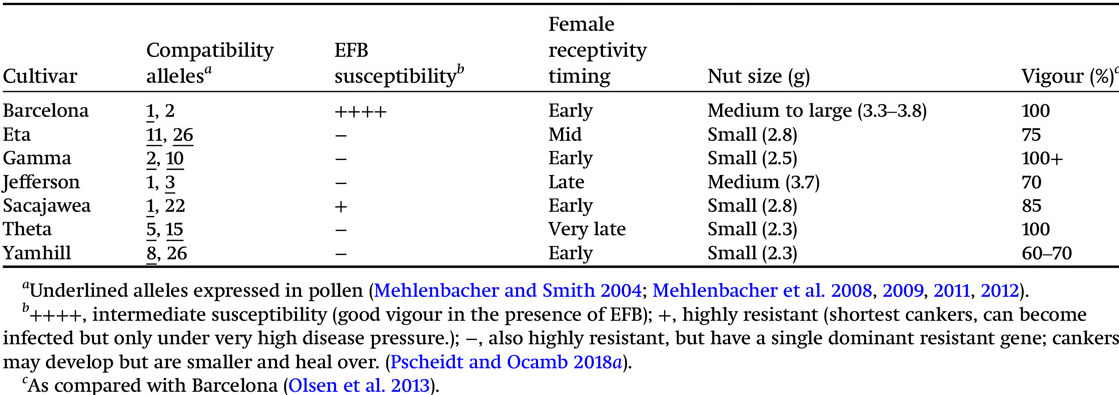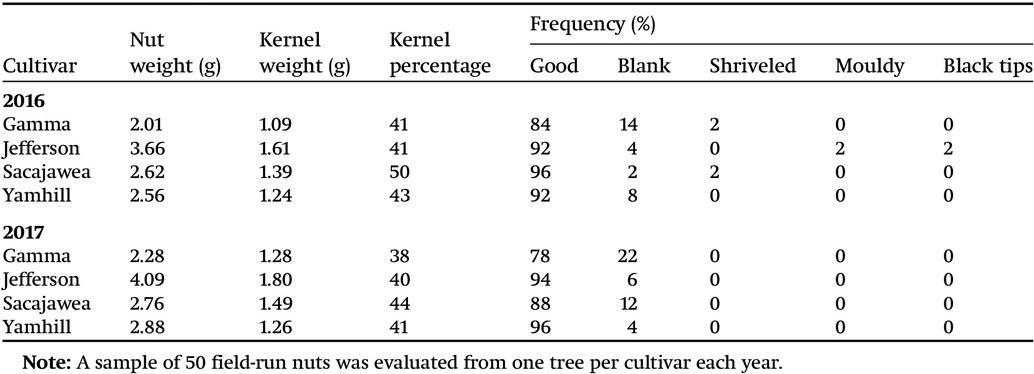Bringing Hazelnuts to BC: Eastern Filbert Blight Resistant Cultivars
About This Brief
This research brief was prepared by the BC Food Web team, based on an article published in the Canadian Journal of Plant Science.
Introduction
Hazelnuts can be a profitable and low-maintenance crop for producers to add to their farms, and the climate of the Fraser Valley and the islands off the coast of southern British Columbia is ideal for growing hazelnut trees. This crop, however, has been reduced in BC due to its susceptibility to Eastern Filbert Blight (EFB), introduced in 2005. This disease, caused by a fungus, primarily affects new growth in the spring. The symptoms of the disease do not become visible until at least 12 to 18 months after initial infection. Once infected with EFB, trees show branch dieback and significant decreases in productivity. If hazelnuts are to be grown widely within British Columbia (BC) again, combatting EFB is an essential step.
There are several management strategies that can help decrease the prevalence and effects of EFB within orchards, which includes pruning to remove infected branches, and fungicide sprays. The most effective strategy, however, is planting cultivars which are resistant to EFB, and Oregon State University (OSU) has been working to develop EFB resistant trees. OSU has developed two general categories of resistance: the Gasaway gene and quantitative. The Gasaway gene is a genetic component that carries a very high level of resistance to the disease. Quantitative resistance within trees results in fewer and smaller infections than more susceptible varieties. Both of these resistance mechanisms are able to decrease the effects of EFB, which in turn aids in the creation of economically profitable hazelnut orchards.
In this experiment, the researcher tested six cultivars of hazelnut trees sourced from Oregon State University at five southwestern British Columbia orchards. The goal was not only to evaluate disease resistance, but also to compare flowering and pollen-shed timing and nut yields of the cultivars. The experiment ran for four to six growing seasons depending on the cultivar. In addition to gaining valuable insight into the effects of both the Gasaway gene and quantitative resistance, two new potential diseases were identified.
Research Process
Five orchard locations were chosen throughout the Fraser Valley and Hornby Island. Four of the five locations (those in the Fraser Valley) already had existing hazelnut orchards, all of which were already infected with EFB to some degree. Six cultivars were selected for planting, and the table below illustrates the characteristics of each cultivar compared to the old industry standard cultivar of Barcelona.
Table 1. Characteristics of six EFB-resistant hazelnut cultivars in comparison to the previous standard, Barcelona.

485 trees were planted at each site. Eta, Jefferson, and Theta were planted at each site in June 2011, and in April 2013 more of these cultivars, plus Gamma, Sacajawea, and Yamhill were planted. Orchard management was by the usual practice of each farmer, and all but one orchard opted against fungicide for EFB prevention.
Disease symptoms were recorded during visits to the orchards by researchers and when observed by farmers. When symptoms not typical of EFB appeared, samples were sent to the BC Ministry of Agriculture Plant Laboratory for testing. In July or August of 2015-2017, four representative trees of each cultivar at each farm were chosen for growth and yield measurements. In July 2017, at each farm, 50 leaves were collected from the oldest trees (Jefferson 2011 planting) for nutrient analysis by the Plant Science Laboratory.
Results
At the conclusion of the experiment, EFB was observed on two cultivars: a few Jefferson trees showed symptoms at three farms, and by 2016 virtually all trees of Sacajawea had symptoms at four farms. No EFB was observed on other cultivars, or on any of the trees on Hornby Island (where preventative fungicide was applied). In addition, two new potential diseases were identified. The first is Phytophthora, which occurred at only one farm, but caused branch dieback, yellowing of leaves, and poor growth. The second disease is Phomopsis, which was observed at three farms and caused branch dieback as well as dark, sunken areas on the stems.
Timing of flowering and pollen shed were highly variable by both year and cultivar. Yamhill and Sacajawea were flowering by early January, Gamma by late January, and Jefferson by late January to mid-February. Pollen shed occurred between late January to early April. The overlap between female receptivity (ie. able to be fertilized) and pollen shed of males ranged from 13 days to 28 days, and some genetically compatible cultivars (e.g. Theta and Yamhill) showed better overlap of pollen shed during female flowering in BC than in Oregon.
In general, nut yields were highest in the oldest plantings; however, it is important to note that yields were highly variable between year, cultivar, and farms. However, Jefferson and Yamhill outcompeted Sacajawea in regards to yield at every farm. Since fungicides were not used at most farms this does not constitute a good comparison of yield for Sacajawea, which was affected by EFB that may have been preventable. The only other cultivar that exceeded these cultivars’ yields was Gamma, which exceeded the yield of Jefferson and Yamhill at one farm. Leaf samples from all farms showed sufficient nutrient content. The table below shows the average nut weights and percentages of ‘good’ nuts for the two years that cultivars reached commercially significant yields. Looking at yield for both 2016 and 2017, Jefferson and Yamhill had the highest frequencies of ‘good’ nuts.
Table 2. Nut weight, kernel percentage, and frequency of defects in four hazelnut cultivars in southwestern British Columbia in each of 2 yr.

Implications
Eastern filbert blight occurred at four out of the five orchards, all of which had infected hazelnut orchards when the new cultivars were planted, and none of which applied fungicide in the first four years after planting. Virtually every Sacajawea tree had symptoms of EFB, indicating this cultivar requires significant EFB management and that Sacajawea’s quantitative resistance is not an immunity. Of the cultivars with Gasaway resistance, only Jefferson developed EFB symptoms, and only at one farm. Despite these challenges, commercial yields were achieved by year four for three cultivars at three farms. With the availability of EFB-resistant cultivars, hazelnuts could once again be an attractive crop for farmers in British Columbia.
Timing of flowering and pollen shed is widely variable by year and by cultivar. Pollen shed, particularly, occurs later in the season than cultivars grown further south, such as Oregon, indicating a need for adjusted management.
In general, this research illustrates the need to utilize best management practices for disease prevention. These include planting resistant varieties, removing old, diseased trees (including hedgerow “volunteers” that host the disease), scouting for diseased and dead limbs, and pruning and burning or chipping affected parts.
With this study taking place at operational orchards with variability in management, this likely contributed to the yield variability and potentially to the contraction of disease. Overall, the experiment helps illustrate that by choosing the right cultivars, Eastern Filbert Blight can be combated and BC could again become a significant exporter of hazelnuts.
About This Research
This brief is based on the following journal article:
O’Dell, T. (2019). Flowering and yield of eastern filbert blight resistant hazelnut cultivars in southwestern British Columbia. Canadian Journal of Plant Science, 99(4), 480-487. https://doi.org/10.1139/cjps-2018-0159
Key Findings
- Two new potential diseases affecting hazelnut cultivars were identified.
- Eastern Filbert Blight occurred at four out of the five orchards.
- The Gasaway gene in EFB resistant cultivars prevented development of symptoms in all but one cultivar at one farm.
- Commercial yields were achieved by year four for three cultivars at three farms, indicating hazelnuts could be a viable crop for production in BC.

